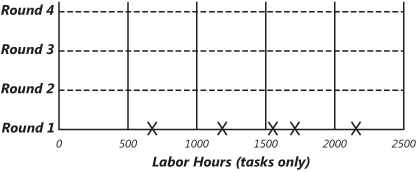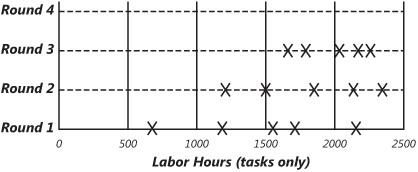The moderator begins the estimation meeting by collecting the participants’ individual estimates and creating a chart such as the one shown in Figure 11-4. Each participant’s total project estimate is plotted as an X on the "Round 1" line. Each estimator can see where his initial value fits along the spectrum. The initial estimates probably will cover a frighteningly large range. Just imagine the different conclusions you might have reached had you asked any one of these five individuals for his estimate!
The moderator does not identify who created each estimate. This anonymity is an important aspect of the Wideband Delphi technique. Anonymity prevents an outspoken colleague from intimidating the other participants into seeing things his way. It also means team members are less likely to defer to a more respected participant’s judgment when their own analyses lead to different conclusions.
Note
Allowing one estimator to dominate the estimation meeting discussion or to attempt to influence the other estimators.
The estimators read their initial task lists aloud, identifying any assumptions made and raising any questions or issues, without revealing their task estimates. Different participants will think of different tasks. Combining these individual task lists leads to a more complete list than any single estimator would produce. This approach will work for up to several dozen individual tasks. If you have more tasks than that you might want to break the problem into several subproblems and estimate them individually.
During this discussion, the team members also talk about their assumptions, estimation issues, and questions they have about the problem. As a result, the team will begin to converge on a shared set of assumptions and a common task list. Retain this final task list to use as a starting point the next time you must estimate a similar activity.
After this initial discussion, all participants modify their estimates concurrently (and silently) in the meeting room. They might revise their task lists based on the information shared during the discussion, and they’ll adjust individual task estimates based on their new understanding of the task scope or changed assumptions. All estimators can add new tasks to their forms and note any changes they wish to make to their initial task estimates. The net change for all tasks equals the change in that participant’s overall project estimate.
Let’s continue with the example in Figure 11-3. Perhaps this estimator learned that some of the user representatives were already identified so he could remove one hour from his estimate for that task. This change of –1 hour appears in the column headed "Change #1." He might have concluded that additional user requirements workshops would be needed and that more reviewers should look at the resulting specification. This resulted in increased estimates for those two tasks, as well as an increase in the estimated time to draft the requirements specification. Maybe a developer who is participating in the estimation workshop stated that he expected to use a new and more efficient prototyping tool, so our estimator reduced the effort needed to develop a prototype by eight hours. However, during the task discussion for estimation round 1, someone else’s task list included the step of correcting errors found during the requirements review. Therefore our estimator added that new task to his list, with an estimate of five hours of effort. The cumulative change from these adjustments made during the second estimation round was an increase of 11 hours, for a revised total estimate of 78 hours.
The moderator collects the revised overall estimates and plots them on the same chart, on the Round 2 line. I’ve done this on a whiteboard for easy visibility. As Figure 11-5 illustrates, the second round might lead to a narrower distribution of estimates centered around a higher mean than the mean of the Round 1 values. Additional rounds should further narrow the distribution. The cycle of revising the task list, discussing issues and assumptions, and preparing new estimates, continues until one of the following conditions is met:
The team has completed four estimation rounds.
The estimates have converged to an acceptably narrow range (defined in advance).
The allotted estimation meeting time (typically two hours) is over.
All participants are unwilling to alter their latest estimates.
Note
Attempting to reach too precise an estimate (that is, too narrow a range) or trying to get all estimators to agree on a single final estimate. Estimation by nature involves uncertainty.
The moderator keeps the group on track, time-boxing discussions for each round to 15 or 20 minutes to avoid endless rambling. The moderator should follow effective meeting facilitation practices: start and end on time; encourage all participants to contribute; maintain an impartial and nonjudgmental environment. While preserving the anonymity of individual estimates is important for the first couple of rounds, the team members might agree at some point to put all their cards on the table and reach closure through an open discussion. This gives them a chance to discuss tasks for which their estimates vary substantially. Otherwise, though, the moderator should not identify the individual who produced each final estimate until the session is completed.


